Acrylic paint is known as a versatile medium, and it can be applied to a broad range of externals. If you’re a beginner in music, you might wish to add some quirky look to your guitar. You can do it using acrylic paint.
Because acrylic paint is equally suitable for canvas and musical instructions, make sure the guitar’s surface is compatible with acrylic paint. With a proper surface, the painting lasts longer, and the original colour is retained. Here are a few practical tips for painting acoustic guitars with acrylic paint.
Sealing the paint is worth it. It extends the paint’s lifespan and protects it from many types of minor scratches and harm. Moreover, it protects the acrylics from fading. Commonly used sealants include Aleene’s paint varnish and spray varnish.
It’s better to determine the best paint for your guitar by reading the instructions on the pack. In general, Krylon or sometimes called Aleene’s spray varnish is a good choice.
Read the article below to learn more about other considerations while painting a guitar with acrylic paint.
Can You Use Acrylic Paint On Guitar?
Yes, acrylic paint can be used on a guitar. Many guitarists choose to customize their instruments by painting them with acrylic paint. However, you should keep in mind that painting a guitar can affect its sound and resonance, so it’s a good idea to take precautions and understand the process before proceeding.
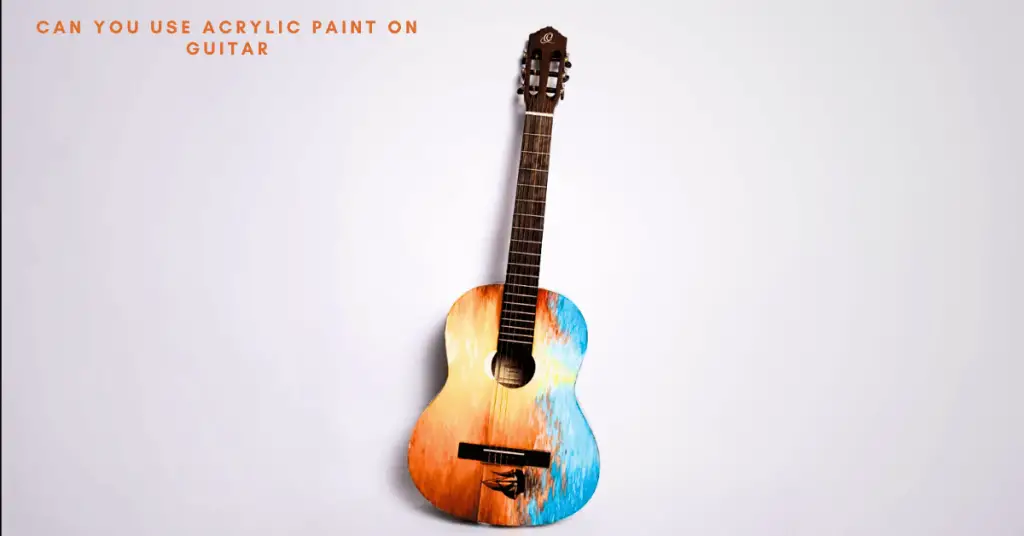
How To Seal Acrylic Paint On Guitar?
Once you have painted your acoustic guitar, you would consider protecting the paint so that it stays for years. For this purpose, a sealant can’t be ignored. It provides additional protection and helps the paint survive wear and tear.
Without a sealer, the paint can’t resist harsh conditions. The colour loses its original tone and fades. It peels off gradually. So better to use a good quality sealer after painting.
Painting the guitar with acrylics is fun, but thick layers of the paint, along with an additional coating of primer and sealer, may affect the guitar’s sound quality. When it comes to sound, the look can be compromised. It is suggested to apply thin layers and avoid overpainting.
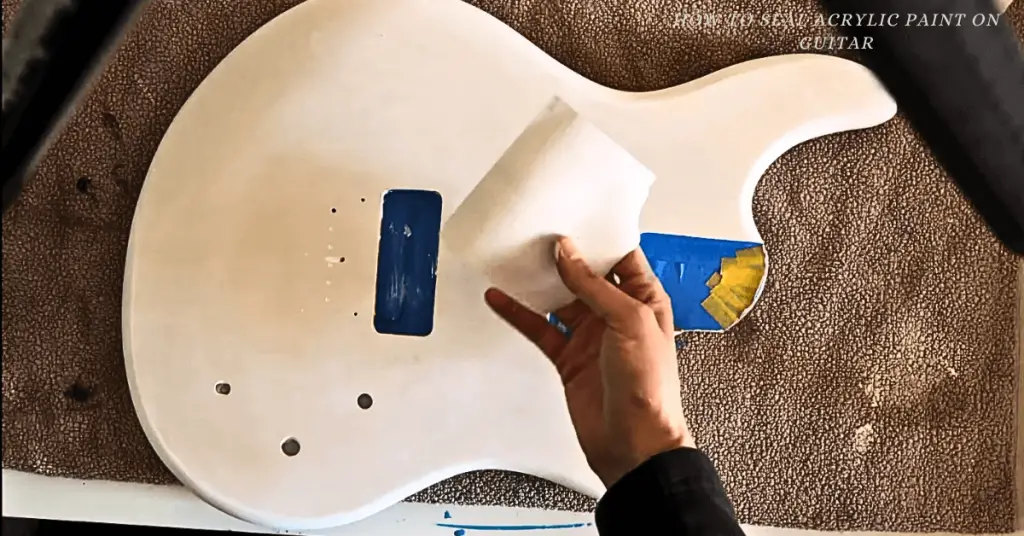
Can You Use Acrylic Paint On An Acoustic Guitar?
Yes, acrylic paint can be taken up on the surface of acoustic guitar. It is fun and wonderful to put a unique glance on your guitar. A few things ought to be held in mind while doing so.
First, clean the guitar surface and get rid of grease or dirt. Next, use sandpaper to form a consistent base for the paint.
Now start painting the guitar surface with multiple acrylics or draw designs of your choice. Thin coats are always recommended. Apply two to three layers of paint. Make sure there is adequate time for drying between the coatings.
Ultimately, seal the acrylic paint with a varnish or clear coat of sealer. It adds extra protection to the paint.
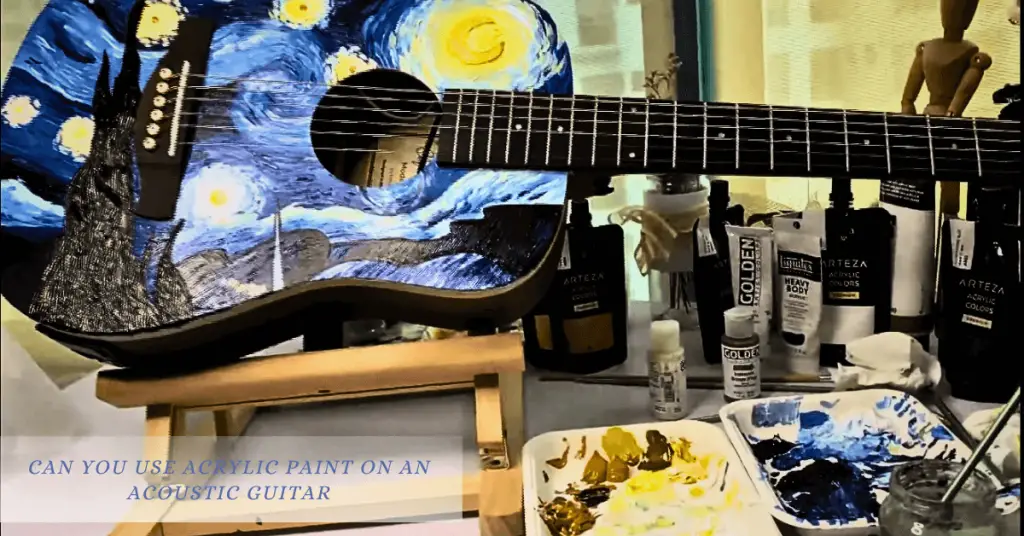
Can You Use Acrylic Paint On An Electric Guitar?
Yes, an electric guitar can be painted with acrylic paint but be more careful as the guitar surface may be a bit smoother than usual. Specifically, if the surface is metal, you must use an extra primer layer. You should understand more about the usage of acrylic paint on metal.
While painting an electric guitar, make sure not to damage the wiring, or if you’re good at reinstalling the guitar, remove all the parts first. It will help you paint and draw designs on the surface without worrying about the guitar’s hardware.
Usually, there is no need to use sandpaper if the surface is metal, as it’s already smooth enough to accept the paint. But cleaning and priming the surface is crucial. It helps the paint adhere and last longer.
Try different designs on your electric guitar. Don’t be afraid of going wrong. There’s a way to correct your mistakes by washing or removing the paint using a variety of safe chemicals.
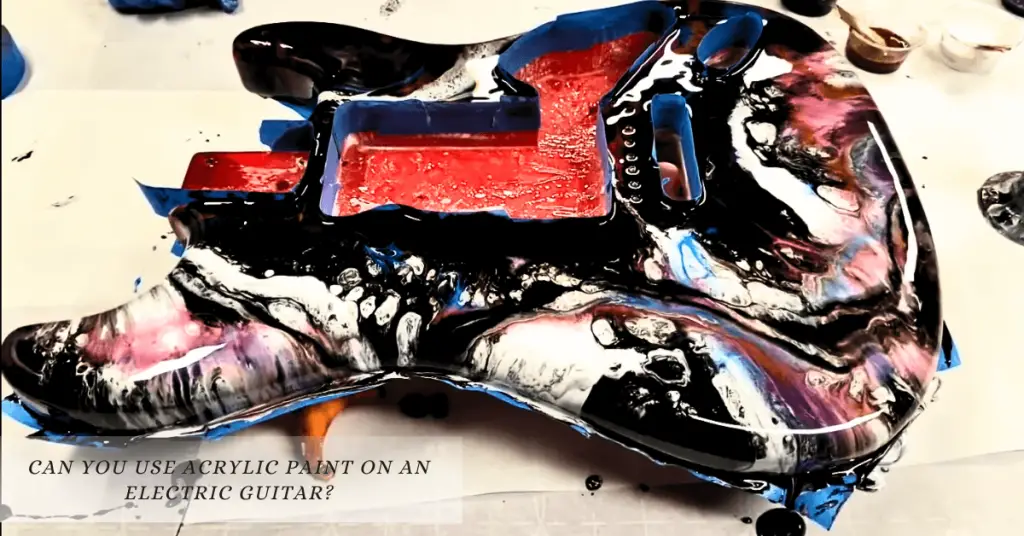
Does The Paint Affect The Sound of Your Instrument?
The fact can’t be ignored that painting the guitar impacts the sound quality or tone of the guitar. Drawing your favourite designs and customising your guitar can be fun and exciting, but it gonna compromise your guitar’s sound. You might be confused about what painting has to do with sound quality. Let us broaden your concept about the topic.
The guitar surface is usually wooden or metal. The space inside the guitar is not purposeless, but it has a lot to do with producing a specific tone. The vibration of the wooden surface and strings produce specific musical sounds. The weight of paint, primer and sealer modifies the oscillations and, ultimately, the sound.
So if you want to decorate your guitar without the sound being spoiled, make sure to apply the paint in thinner layers and avoid over-painting and priming—moreover, clean and sand down the surface well for better results.
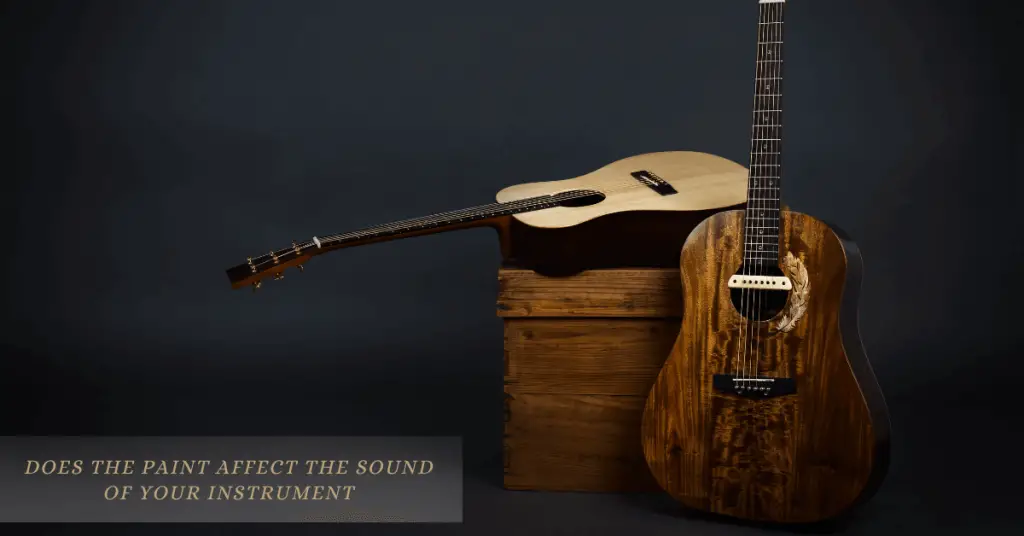
What Kind Of Paint Do You Use On An Acoustic Guitar?
Any type of paint consistent with the surface of the acoustic guitar can be utilised to paint it. However, it should fulfil your requirements as well. Nitrocellulose lacquer is a commonly used paint on musical instruments for its durability, long-lasting effects and mirror finish.
Another type is acrylic paint, along with polyurethane and varnishes. It is a perfect combination. It’s all about interests and creative ideas while choosing a specific paint for your guitar.
You have to consider a few practices in order to get the best output. House paint or auto paints are not compatible with guitar surfaces. They’ll not work, so don’t waste your cash and time on taking them up. They’ll not adhere to the guitar surface. So better to do some research before going for a specific paint.
Sanding the surface is a plus point before applying the paint. It provides a way for the polymer to sit onto. Try different designs, and don’t be afraid of mistakes. They are reversible with some effective cleaning agents.
Can You Use Acrylic Paint Directly On Wood?
Yes, wood can be painted directly with acrylic paint. Make sure to follow some practical instructions in order to get the results according to your expectation. The wood surface is absorbent, helping acrylics get dry faster. Moreover, the surface is kind of rough, so there’s no need to sand down it.
A primer must be used to make the bond between the surface and paint strong. It ensures durability, and the paint will not flake off. Cleaning the surface and getting rid of dust particles is crucial. It reduces the possibility of paint contamination.
The wooden surface is light on pocket and can be found at any furniture or hardware shop. You’ll end up with a cracked surface without proper preparation before painting.
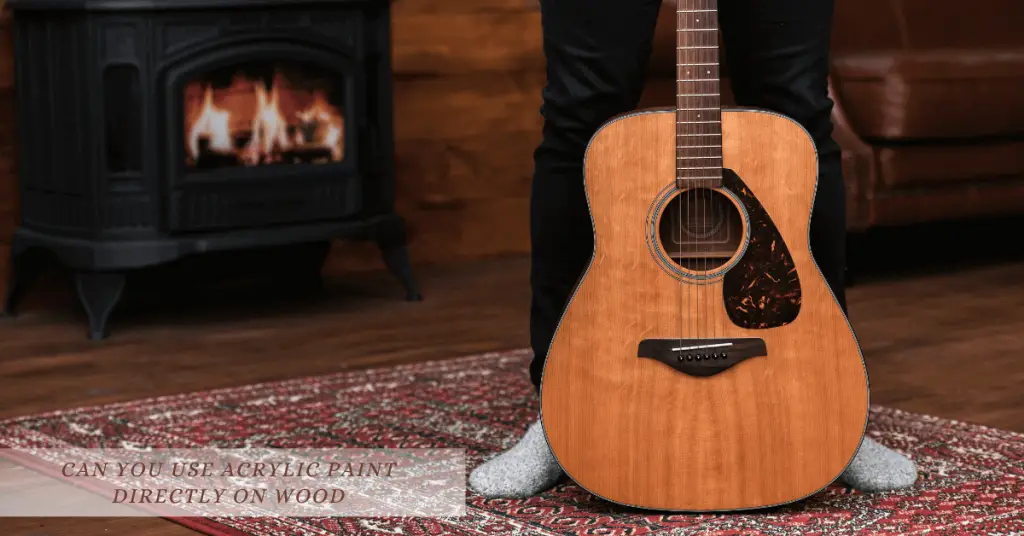
Does Painting A Guitar Affect Its Sound?
Yes, painting a guitar can affect the sound quality. The reason is loud and clear. The wooden body of the guitar, which is also known as the soundboard, has thin walls. The vibration of the soundboard produces specific sounds. So even a little weight over the board can alter sound quality. Painting alters the weight leading to disturbance in the music.
But there is a psychological fact too, behind the sound quality and guitar paint. For instance, the brighter or more colourful look of the guitar gives a spark to the musician, while dark colours may lead to a melancholy feeling which ultimately affects the musician’s playing style.
So better to apply thinner layers while painting the guitar and choose brighter and more vibrant colours that are soothing to mood and eyes.

What Affects The Tone Of A Guitar?
Several factors influence the sound and can modify the tone of a guitar. The primary cause is thicker layers of paint. The weight of the paint dampens the vibrations. While thinner layers, on the other hand, are less likely to change vibrations.
The type of wood used in the guitar’s body plays its role too. The side walls don’t affect the sound if unplugged. Tension in the strings is the main factor when talking about the tone. The tension can be made over according to the music and style of playing.
What To Keep In Mind?
Painting is always a fun and stress-relieving practice, especially when it comes to decorating your favourite toys or musical instruments. But there are some concerns you have to take into account.
Firstly, select a compatible type of paint that can adhere to the surface you plan to decorate. Polyurethane or nitrocellulose are good options for a solid colour along with permanence.
Some paints, like the ones mentioned above, can dry even faster than water-based paints. So choose the one which is easy to work with and has an appropriate dry time.
If you’re not sure what kind of paint you should choose, we suggest you try Arteza acrylic paint. It is perfect for painting on a guitar.
FAQs
Can you use any paint on a guitar?
Several paints with distinctive features can be used on the guitar, including acrylics and enamel. Sometimes lacquer is used as well. Every painting is unique in its drawbacks and advantages.
Can I paint a guitar with wall paint?
Every paint is designed for a specific purpose and surface. We can’t say wall paint will not work on guitar, but it will not be as durable as expected. Some paints are synthesised for walls while others are prepared specially for decoration. So you have to consider the one with the best outputs.
How do I protect the guitar’s hardware and electronics when painting?
It’s best to remove hardware and electronics before painting the guitar. If that’s not possible, you can cover these parts with painter’s tape or masking tape to protect them from paint.
How many coats of acrylic paint should I apply?
The number of coats needed can vary depending on the desired color intensity and the type of acrylic paint used. Typically, two or three thin coats are sufficient for good coverage.
Conclusion:
The outcome of our discussion is yes; we can use acrylics on guitars. There can be some uppers and downs of doing such an exciting task, but the results will be fruitful if you have the proper knowledge and possess relevant expertise.
Thank you for going over it! I hope you find it helpful.
- How To Buff Acrylic Enamel Paint In 5 Easy Steps? Thorough Guidance - February 2, 2024
- How To Make Acrylic Paint More Opaque? 10 Effective Methods - February 1, 2024
- How To Sketch On Canvas Before Acrylic Painting? Draw Like a Pro - January 31, 2024

